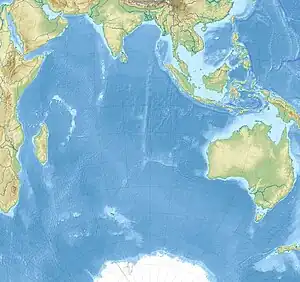Burckle Crater
The Burckle crater is an undersea topographic feature about 29 kilometres (18 mi; 16 nmi) in diameter[1] in the southwestern Indian Ocean. A team of Earth scientists called the Holocene Impact Working Group propose the feature to be an impact crater; these claims are disputed by other geologists.[2]
| Burckle crater | |
|---|---|
 Burckle crater Location of Burckle Crater in the Indian Ocean | |
| Impact crater/structure | |
| Confidence | Hypothesized, contested |
| Diameter | ~29 km (18 mi; 16 nmi) |
| Depth | 3,800 m (12,500 ft) |
| Age | ~5000 years (Holocene) |
| Exposed | No |
| Drilled | No |
| Bolide type | Unknown, possibly remains of a comet |
| Location | |
| Coordinates | 30.865°S 61.365°E |
Description
The feature is located east of Madagascar and west of Western Australia in the southern Indian ocean, adjacent to the SW Indian Ocean Ridge. Its position was determined in 2006 by the Holocene Impact Working Group using prehistoric chevron dune formations in Australia and Madagascar. Based on the hypothesis these dunes were formed by a megatsunami resulting from an impact, the researchers were able to triangulate the location of Burckle crater. The hypothesis that these chevron dunes were caused by a megatsunami has been challenged by geologists Jody Bourgeois and R. Weiss in 2009. Using a computer model to simulate a tsunami, they argue that the structures are more consistent with aeolian processes.[3] The tsunami origin of these chevrons is also disputed by other Earth scientists.[2]
Other problems with the claim include:
- The Holocene Impact Working Group has suggested that multiple significant impact events occurred in the past 10,000 years, but astrononomical models indicate that impact events large enough to cause "hazardous tsunamis" should be expected only about once per 100,000 years, making the Working Group's claims improbable enough that they call for very strong evidence.[2]
- The evidence for their claims is mostly based on the locations of coastal sedimentary deposits that they have identified and termed "chevrons", and interpret as having been caused by run-up from impact-generated megatsunamis. Other geologists before and after the Working Group consider them to be parabolic sand dunes. The chevrons in Madagascar are precisely aligned with the normal prevailing wind direction at the site as shown by modern weather data, implying that they likely were deposited gradually by wind under present-day conditions, as sand dunes, and not in a catastrophic tsunami.[2]
- The Working Group reported finding nickel and iron splash droplets fused to foraminiferal tests in slides taken from deep ocean cores near Burckle Crater. But this interpretation is problematic because formaminifera tests are calcium carbonate, which chemically decomposes at about 500 degrees C, while nickel and iron melt at temperatures higher than 1400 degrees C. Additionally, comparable splash droplets fused to foraminifera tests have not been reported from any of the sediment studies done near Chicxulub crater.[2]
- Setting out to identify past impact events by looking for holes in the ground has often proven dubious as a methodology, including the time a sheep watering hole was called "Sirente Crater".[2]
Burckle crater is located at 30.865°S 61.365°E in the Indian Ocean and is 3,800 metres (12,500 ft) below the surface.
See also
References
- Abbott et al., 2006
- Pinter & Ishman, 2008, p.37
- Bourgeois & Weiss, 2009
Bibliography
- Abbott, D.H.; S.N. Martos; H.D. Elkinton; E.F. Bryant; V. Gusiakov, and D. Breger. 2006. Impact craters as sources of megatsunami generated chevron dunes. Geological Society of America Abstracts with Programs 38. 299. Accessed 2019-02-25.
- Abbott, D.H.; P. Gerard-Little; S. Costa, and D. Breger. 2009. Odd (CaCO3) from the Southwest Indian Ocean near Burckle Crater candidate; impact ejecta or hydrothermal precipitate?. Abstracts of Papers Submitted to the Lunar and Planetary Science Conference, Houston, Texas, abstract 2243 40. 1–2. Accessed 2019-02-25.
- Bourgeois, J., and R. Weiss. 2009. 'Chevrons' are not mega-tsunami deposits; a sedimentologic assessment. Geology 37. 403–406. Accessed 2019-02-25.
- Pinter, N., and S.E. Ishman. 2008. Impacts, mega-tsunami, and other extraordinary claims. GSA Today 18. 37–38. Accessed 2019-02-25.
External links
- Anonymous (2009) Past Tsunamis? Contrary To Recent Hypothesis, 'Chevrons' Are Not Evidence Of Megatsunamis. ScienceDaily, April 30, 2009.
- Colvin, M. (2006) Researchers claim link between tsunamis and outer space." ABC News, Australia (Transcript of ABC interview with Ted Bryant) November 14, 2006.

